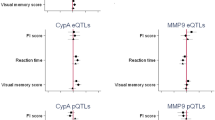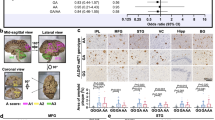Abstract
Cerebral accumulation of β-amyloid peptide (Aβ) is a central event in the pathogenesis of Alzheimer's disease (AD). Endothelin-converting enzyme-1 (ECE-1) is a candidate Aβ-degrading enzyme in brain, but its involvement in AD pathogenesis was never assessed. We first performed brain immunocytochemistry, using a monoclonal anti-ECE-1 antibody, and observed neuronal ECE-1 expression in various cortical regions of nondemented subjects. In the hippocampus, ECE-1 immunoreactivity showed a stereotypical pattern inversely correlated with susceptibility to Aβ deposition, further suggesting a physiological role in Aβ clearance. In order to undertake a genetic association study, we identified a functional genetic variant (ECE1B C-338A) located in a regulatory region of the ECE1 gene. We showed that the A allele is associated with increased transcriptional activity in promoter–reporter gene assays and with increased ECE-1 mRNA expression in human neocortex. In a case–control study involving 401 patients with late-onset AD and 461 aged controls, we found that homozygous carriers of the A allele had a reduced risk of AD (OR=0.47, 95% CI 0.25–0.88). This finding was strengthened by the analysis of two other genetic variants of the ECE1 gene, which showed that the genetic association is extended over at least 13 kilobases of the gene sequence. Our results suggest that ECE-1 expression in brain may be critical for cortical Aβ clearance and offer new potential targets for therapeutic interventions in AD.
This is a preview of subscription content, access via your institution
Access options
Subscribe to this journal
Receive 12 print issues and online access
$259.00 per year
only $21.58 per issue
Buy this article
- Purchase on Springer Link
- Instant access to full article PDF
Prices may be subject to local taxes which are calculated during checkout


Similar content being viewed by others
References
Naslund J, Haroutunian V, Mohs R, Davis KL, Davies P, Greengard P et al. Correlation between elevated levels of amyloid beta-peptide in the brain and cognitive decline. JAMA 2000; 283: 1571–1577.
Delacourte A, Sergeant N, Champain D, Wattez A, Maurage CA, Lebert F et al. Nonoverlapping but synergetic tau and APP pathologies in sporadic Alzheimer's disease. Neurology 2002; 59: 398–407.
Hardy J, Selkoe DJ . The amyloid hypothesis of Alzheimer's disease: progress and problems on the road to therapeutics. Science 2002; 297: 353–356.
Tanzi RE, Bertram L . New frontiers in Alzheimer's disease genetics. Neuron 2001; 32: 181–184.
Holsinger RM, McLean CA, Beyreuther K, Masters CL, Evin G . Increased expression of the amyloid precursor beta-secretase in Alzheimer's disease. Ann Neurol 2002; 51: 783–786.
Fukumoto H, Cheung BS, Hyman BT, Irizarry MC . Beta-secretase protein and activity are increased in the neocortex in Alzheimer disease. Arch Neurol 2002; 59: 1381–1389.
Yang LB, Lindholm K, Yan R, Citron M, Xia W, Yang XL et al. Elevated beta-secretase expression and enzymatic activity detected in sporadic Alzheimer disease. Nat Med 2003; 9: 3–4.
Selkoe DJ . Deciphering the genesis and fate of amyloid beta-protein yields novel therapies for Alzheimer disease. J Clin Invest 2002; 110: 1375–1381.
Selkoe DJ . Clearing the brain's amyloid cobwebs. Neuron 2001; 32: 177–180.
Carson JA, Turner AJ . Beta-amyloid catabolism: roles for neprilysin (NEP) and other metallopeptidases? J Neurochem 2002; 81: 1–8.
Iwata N, Tsubuki S, Takaki Y, Shirotani K, Lu B, Gerard NP et al. Metabolic regulation of brain Abeta by neprilysin. Science 2001; 292: 1550–1552.
Eckman EA, Watson M, Marlow L, Sambamurti K, Eckman CB . Alzheimer's disease beta-amyloid peptide is increased in mice deficient in endothelin-converting enzyme. J Biol Chem 2003; 278: 2081–2084.
Farris W, Mansourian S, Chang Y, Lindsley L, Eckman EA, Frosch MP et al. Insulin-degrading enzyme regulates the levels of insulin, amyloid beta-protein, and the beta-amyloid precursor protein intracellular domain in vivo. Proc Natl Acad Sci USA 2003; 100: 4162–4167.
Miller BC, Eckman EA, Sambamurti K, Dobbs N, Chow KM, Eckman CB et al. Amyloid-beta peptide levels in brain are inversely correlated with insulysin activity levels in vivo. Proc Natl Acad Sci USA 2003; 100: 6221–6226.
Turner AJ, Tanzawa K . Mammalian membrane metallopeptidases: NEP, ECE, KELL, and PEX. FASEB J 1997; 11: 355–364.
Akiyama H, Shii K, Yokono K, Yonezawa K, Sato S, Watanabe K et al. Cellular localization of insulin-degrading enzyme in rat liver using monoclonal antibodies specific for this enzyme. Biochem Biophys Res Commun 1988; 155: 914–922.
Akiyama H, Kondo H, Ikeda K, Kato M, McGeer PL . Immunohistochemical localization of neprilysin in the human cerebral cortex: inverse association with vulnerability to amyloid beta-protein (Abeta) deposition. Brain Res 2001; 902: 277–281.
Carpentier M, Robitaille Y, DesGroseillers L, Boileau G, Marcinkiewicz M . Declining expression of neprilysin in Alzheimer disease vasculature: possible involvement in cerebral amyloid angiopathy. J Neuropathol Exp Neurol 2002; 61: 849–856.
Bernstein HG, Ansorge S, Riederer P, Reiser M, Frolich L, Bogerts B . Insulin-degrading enzyme in the Alzheimer's disease brain: prominent localization in neurons and senile plaques. Neurosci Lett 1999; 263: 161–164.
Cook DG, Leverenz JB, McMillan PJ, Kulstad JJ, Ericksen S, Roth RA et al. Reduced hippocampal insulin-degrading enzyme in late-onset Alzheimer's disease is associated with the apolipoprotein E-epsilon4 allele. Am J Pathol 2003; 162: 313–319.
Sodeyama N, Mizusawa H, Yamada M, Itoh Y, Otomo E, Matsushita M . Lack of association of neprilysin polymorphism with Alzheimer's disease and Alzheimer's disease-type neuropathological changes. J Neurol Neurosurg Psychiatry 2001; 71: 817–818.
Oda M, Morino H, Maruyama H, Terasawa H, Izumi Y, Torii T et al. Dinucleotide repeat polymorphisms in the neprilysin gene are not associated with sporadic Alzheimer's disease. Neurosci Lett 2002; 320: 105–107.
Clarimon J, Munoz FJ, Boada M, Tarraga L, Sunyer J, Bertranpetit J et al. Possible increased risk for Alzheimer's disease associated with neprilysin gene. J Neural Transm 2003; 110: 651–657.
Boussaha M, Hannequin D, Verpillat P, Brice A, Frebourg T, Campion D . Polymorphisms of insulin-degrading enzyme gene are not associated with Alzheimer's disease. Neurosci Lett 2002; 329: 121–123.
Prince JA, Feuk L, Gu HF, Johansson B, Gatz M, Blennow K et al. Genetic variation in a haplotype block spanning IDE influences Alzheimer disease. Hum Mutat 2003; 22: 363–371.
Subkowski T, Hillen H, Kroger B, Schmidt M . Monoclonal antibodies against human endothelin-converting enzyme-1. J Immunoassay 1998; 19: 75–93.
Ito C, Morisset S, Krebs MO, Olie JP, Loo H, Poirier MF et al. Histamine H2 receptor gene variants: lack of association with schizophrenia. Mol Psychiatry 2000; 5: 159–164.
Quandt K, Frech K, Karas H, Wingender E, Werner T . MatInd and MatInspector: new fast and versatile tools for detection of consensus matches in nucleotide sequence data. Nucleic Acids Res 1995; 23: 4878–4884.
Goidin D, Mamessier A, Staquet MJ, Schmitt D, Berthier-Vergnes O . Ribosomal 18S RNA prevails over glyceraldehyde-3-phosphate dehydrogenase and beta-actin genes as internal standard for quantitative comparison of mRNA levels in invasive and noninvasive human melanoma cell subpopulations. Anal Biochem 2001; 295: 17–21.
Thal DR, Rub U, Schultz C, Sassin I, Ghebremedhin E, Del Tredici K et al. Sequence of Abeta-protein deposition in the human medial temporal lobe. J Neuropathol Exp Neurol 2000; 59: 733–748.
Valdenaire O, Lepailleur-Enouf D, Egidy G, Thouard A, Barret A, Vranckx R et al. A fourth isoform of endothelin-converting enzyme (ECE-1) is generated from an additional promoter molecular cloning and characterization. Eur J Biochem 1999; 264: 341–349.
Valdenaire O, Rohrbacher E, Mattei MG . Organization of the gene encoding the human endothelin-converting enzyme (ECE-1). J Biol Chem 1995; 270: 29794–29798.
Schweizer A, Valdenaire O, Nelbock P, Deuschle U, Dumas Milne Edwards JB, Stumpf JG et al. Human endothelin-converting enzyme (ECE-1): three isoforms with distinct subcellular localizations. Biochem J 1997; 328: 871–877.
Funke-Kaiser H, Reichenberger F, Kopke K, Herrmann SM, Pfeifer J, Orzechowski HD et al. Differential binding of transcription factor E2F-2 to the endothelin-converting enzyme-1b promoter affects blood pressure regulation. Hum Mol Genet 2003; 12: 423–433.
Shirotani K, Tsubuki S, Iwata N, Takaki Y, Harigaya W, Maruyama K et al. Neprilysin degrades both amyloid beta peptides 1–40 and 1–42 most rapidly and efficiently among thiorphan- and phosphoramidon-sensitive endopeptidases. J Biol Chem 2001; 276: 21895–21901.
Eckman EA, Reed DK, Eckman CB . Degradation of the Alzheimer's amyloid beta peptide by endothelin-converting enzyme. J Biol Chem 2001; 276: 24540–24548.
Yang Q, Khoury MJ, Botto L, Friedman JM, Flanders WD . Improving the prediction of complex diseases by testing for multiple disease-susceptibility genes. Am J Hum Genet 2003; 72: 636–649.
Farrer LA, Cupples LA, Haines JL, Hyman B, Kukull WA, Mayeux R et al. Effects of age, sex, and ethnicity on the association between apolipoprotein E genotype and Alzheimer disease. A meta-analysis. APOE and Alzheimer Disease Meta Analysis Consortium. JAMA 1997; 278: 1349–1356.
Muller L, Barret A, Etienne E, Meidan R, Valdenaire O, Corvol P et al. Heterodimerization of endothelin-converting enzyme-1 isoforms regulates the subcellular distribution of this metalloprotease. J Biol Chem 2003; 278: 545–555.
Huse JT, Pijak DS, Leslie GJ, Lee VM, Doms RW . Maturation and endosomal targeting of beta-site amyloid precursor protein-cleaving enzyme. The Alzheimer's disease beta-secretase. J Biol Chem 2000; 275: 33729–33737.
Perez RG, Soriano S, Hayes JD, Ostaszewski B, Xia W, Selkoe DJ et al. Mutagenesis identifies new signals for beta-amyloid precursor protein endocytosis, turnover, and the generation of secreted fragments, including Abeta42. J Biol Chem 1999; 274: 18851–18856.
Yamazaki T, Chang TY, Haass C, Ihara Y . Accumulation and aggregation of amyloid beta-protein in late endosomes of Niemann-pick type C cells. J Biol Chem 2001; 276: 4454–4460.
Mathews PM, Jiang Y, Schmidt SD, Grbovic OM, Mercken M, Nixon RA . Calpain activity regulates the cell surface distribution of amyloid precursor protein. Inhibition of clapains enhances endosomal generation of beta-cleaved C-terminal APP fragments. J Biol Chem 2002; 277: 36415–36424.
Cataldo AM, Peterhoff CM, Troncoso JC, Gomez-Isla T, Hyman BT, Nixon RA . Endocytic pathway abnormalities precede amyloid beta deposition in sporadic Alzheimer's disease and Down syndrome: differential effects of APOE genotype and presenilin mutations. Am J Pathol 2000; 157: 277–286.
Acknowledgements
We thank Dr Suzanne Trottier and Dr Pierre Sokoloff for their help in the preparation of the manuscript.
Author information
Authors and Affiliations
Corresponding author
Supplementary information
Rights and permissions
About this article
Cite this article
Funalot, B., Ouimet, T., Claperon, A. et al. Endothelin-converting enzyme-1 is expressed in human cerebral cortex and protects against Alzheimer's disease. Mol Psychiatry 9, 1122–1128 (2004). https://doi.org/10.1038/sj.mp.4001584
Received:
Revised:
Accepted:
Published:
Issue Date:
DOI: https://doi.org/10.1038/sj.mp.4001584
Keywords
This article is cited by
-
Histone acetylation in an Alzheimer’s disease cell model promotes homeostatic amyloid-reducing pathways
Acta Neuropathologica Communications (2024)
-
Endothelin-converting Enzyme-1b Genetic Variants Increase the Risk of Coronary Artery Ectasia
Biochemical Genetics (2024)
-
Intranasal H102 Peptide-Loaded Liposomes for Brain Delivery to Treat Alzheimer’s Disease
Pharmaceutical Research (2015)
-
Simulated Interactions between Endothelin Converting Enzyme and Aβ Peptide: Insights into Subsite Recognition and Cleavage Mechanism
International Journal of Peptide Research and Therapeutics (2014)
-
Impaired amyloid β-degrading enzymes in brain of streptozotocin-induced diabetic rats
Journal of Endocrinological Investigation (2011)



